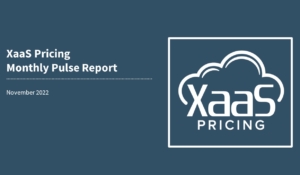Diving into the research to look at whether generative AI is the next hype wave, or a secular and disruptive trend
Nov. 24, 2022
Author: Bryan Belanger
Nov. 24, 2022
Author: Bryan Belanger

Several of our recent posts have been more of the “how to” variety, so we’ve been eager to do something that’s a little more topical and more of a vendor or category deep dive.
Pretty much the entire SaaS industry has been talking about Elon-era Twitter and the $8 Twitter Blue subscription plan. It is undeniably a juicy pricing topic and has stoked some interesting pricing and packaging discourse. Admittedly, however, we’re a little sick of it at this point, and Patrick Campbell of Paddle already said pretty much everything we’d say about it anyway. So cross that off the list.
One area that’s been at the forefront of SaaS recently is generative AI, a category of AI tools and applications that create novel outputs (e.g., text, code, images, audio, video) versus AI applications that just ingest, process and act upon pre-existing data. Many are anticipating 2023 to be the year of generative AI and expect the category will have long-term disruptive impacts on software overall.
This might sound a little familiar; 2022 was the year of web3, and much attention and investment dollars were directed toward web3 companies. Since this anointment, web3 companies, many of which were focused on blockchain, cryptocurrency, decentralized finance and related areas, have tumbled, flamed out, or cratered in spectacular fashion. The most notable of these was FTX, which we certainly don’t have time to get into here.
So why is generative AI different?
We’re not quite sure it is. It’s probably a little early to tell. It certainly seems to be following the same gold rush hype wave that carried web3 in 2022. But there’s one difference that’s clear with generative AI versus web3. There are real products, focusing on real use cases, that are currently in the market, with transparent pricing and packaging published on company websites. This provides us with an opportunity to dissect the monetization strategies of early players and assess whether there are paths to building sustainable, revenue-generating subscription businesses in the space.
Venture capital firm Sequoia has put the most definitive and well-publicized stake in the ground that we’ve seen to date around creating the category that is generative AI. Sequoia put out a living and breathing market map for the generative AI landscape, which can be found here.
Sequoia organizes the ecosystem, which includes 50-plus vendors, around seven pillar categories: text, video, image, code, 3D, speech and other. Each of these categories has between two and six subcategories. Overall, by the way, this is an encouraging start for generative AI. This map may be a little feature-centric, but it’s encouraging to see there are actual use cases forming, particularly in the subcategories. For example, within “code” there are subcategories for code generation, documentation, web app builders and text to SQL. These are actually real jobs that a customer might be looking to get done! Side note: If I were Sequoia, I might think about using these output/outcome-focused subcategories as the pillars, rather than using the technology (e.g., text versus video) as the organizing hierarchy. You could envision a future where there are speech tools that help with code generation, for example.
This market map isn’t fully representative of this space, but it’s as good of a place to start as any for tracking monetization in this evolving ecosystem. In the sections that follow, we share our impressions of the current state and possible future state of generative AI monetization based on a scan of the players in the space from across Sequoia’s market map.
There’s one big caveat here that we think also bears watching: the Sequoia map and the discourse on generative AI overall are currently focusing largely on stand-alone startups that are offering technology in this space. That makes sense. But we think a much bigger evolution will occur when larger, more well-established companies start embedding these technologies into their existing SaaS products, via either their own development efforts or acquisition. That’s a whole other lens through which to evaluate packaging and pricing evolution and monetization strategy. It’s probably a little early for tracking that dimension, so we’ll focus on the stand-alone players here and cover embedded use cases in a future post.
Turns out that good-better-best is, well, best — at least when it comes to getting started with a packaging model for generative AI.
Most of the players in this space across categories offer between two and four product tiers. Many offer a free forever plan or a low-priced paid plan as an entry point offer, and then offer a standard single user/baseline plan and one or two more premium plans, typically targeting teams and/or enterprises with variable usage requirements.
Usage of products is gated to create a fence encouraging customers to migrate from free or entry-level to premium paid plans. Usage gates vary based on the category and vendor but typically follow similar constructs as we’ve observed in SaaS overall. Usage is gated most aggressively for free plans, and then usage limits are lifted as the customer migrates to paid plans. Usage is generally defined based on three to five key value metrics across plans.
Overall, it seems the generative AI ecosystem is drafting off the successes of the tried-and-true good-better-best model for SaaS. Packaging appears to be primarily designed to cater to personas based on size, scaling from free and individual prosumer plans to team and enterprise plans for broader departmental or business usage.
There’s nothing wrong with the approaches here — they are recognizable, easy for customers to understand, and clearly presented. We do think, however, that packaging in this ecosystem reflects the ecosystem’s maturity. Most of these companies are building products that are primarily aimed at attracting and engaging generalist early adopter users, who may be trialing these products for their personal side hustle projects and/or for business purposes, or both. The predominant strategy appears to be focused on activating and engaging these prosumer users, and then offering plans that make it easy for these users to recommend these products to their teams for broader business usage.
Pricing models used in generative AI are aligned to the most common current constructs used by SaaS companies overall. There is greater variability in choice of pricing model versus choice of packaging model across the landscape, with some trends seeming to emerge within each generative AI subcategory.
Across categories, most companies are using monthly and annual subscription models with prices that are based on a flat fee or seats, with usage limits defined by plan. For some companies that don’t price based on users, these usage limits also include a cap on the number of users for a given plan. Pure usage-based pricing is employed by some vendors, although it is not common.
Here are a few examples of the predominant models we’re seeing emerge for pricing generative AI:
We’ve written before about the idea of “do it for you” in SaaS. We first heard of the concept (no surprise) when ProfitWell was acquired by Paddle, and we fully agree with them that “do it for you” will dictate the next major wave of SaaS innovation.
SaaS proliferation within businesses small and large has created tool overload. Many tools were adopted for the sake of having a tool, and this resulted in SaaS sprawl, shadow buying and runaway software spending overall. As companies pivot to contain costs, they’ll rationalize their software footprint and focus more acutely on software that actually makes their lives easier. In fact, this is already happening in response to the uncertain economic outlook for 2023. The software that has staying power will deliver measurable and tangible value by helping complete a job-to-be-done in a way that creates new revenue, secures existing revenue, reduces costs and/or reduces risk.
We’ve hypothesized this market evolution to “do it for you” may have a corresponding impact on how vendors that succeed in that paradigm choose to monetize software. “Do it for you” suggests that the software delivers at minimum a successful output (example: invoices are processed) and, better yet, a successful outcome (invoices are processed with 100% accuracy and 100% timeliness).
In a “do it for you” world, this means you have two options as a vendor: link monetization to the output you deliver (plan XYZ supports up to 100 invoices processed monthly and is priced at a flat fee of $100 or is priced $1 per invoice processed), or link monetization to the outcome you deliver (plan XYZ is priced at X% of invoice volume for invoices collected on or before term).
Here’s where generative AI comes in. We believe generative AI has potential to be a killer app that helps software evolve to actually deliver outputs or, even better, outcomes. Why? That’s the core premise of generative AI as a capability — to generate novel assets, be it text, code, audio or something else, for some defined purpose. Perhaps in some instances today these products are generating assets for generation’s sake (we haven’t done a deep dive feature test for diligence on this, so it’s more of a hypothesis), but the idea is that they’ll evolve over time to tighten focus on target customers and use cases.
It would stand to reason, then, that with that evolution will come monetization models that focus on outputs and outcomes. Stand-alone generative AI software companies certainly have this opportunity but so will other software players that are aiming to embed generative AI to add features and/or services to solve customer problems.
Generative AI is already mostly in “output-based monetization” world today. Text-based platforms such as Copy.ai and Jasper are pricing based on the number of words delivered by their tools on a monthly basis. AP automation AI platform Glean packages based on the number of processed invoices.
If we agree on the “do it for you” trajectory and believe generative AI will be a key conduit for that, how will monetization in the space evolve? Here are a few predictions:
We’re looking forward to watching how this space evolves and how quickly monetization (not venture funding) strategies help turn these technologies into sustainable businesses. We’ll be watching and analyzing as we go, as usual.
Any questions on generative AI monetization? Want to throw ideas around, profile a particular company or deep dive on how these trends might impact your business? You can find me on Twitter at @bbelangerTBR or send your feedback directly to [email protected]. Be sure as always to subscribe to get our content sent to your inbox once it publishes. Thanks for following along!
 ©2022 XaaS Pricing. All rights reserved. Terms of Service | Website Maintained by Tidal Media Group
©2022 XaaS Pricing. All rights reserved. Terms of Service | Website Maintained by Tidal Media Group
 XaaS Pricing
XaaS Pricing Leveraging research to optimize account-based sales
Leveraging research to optimize account-based sales